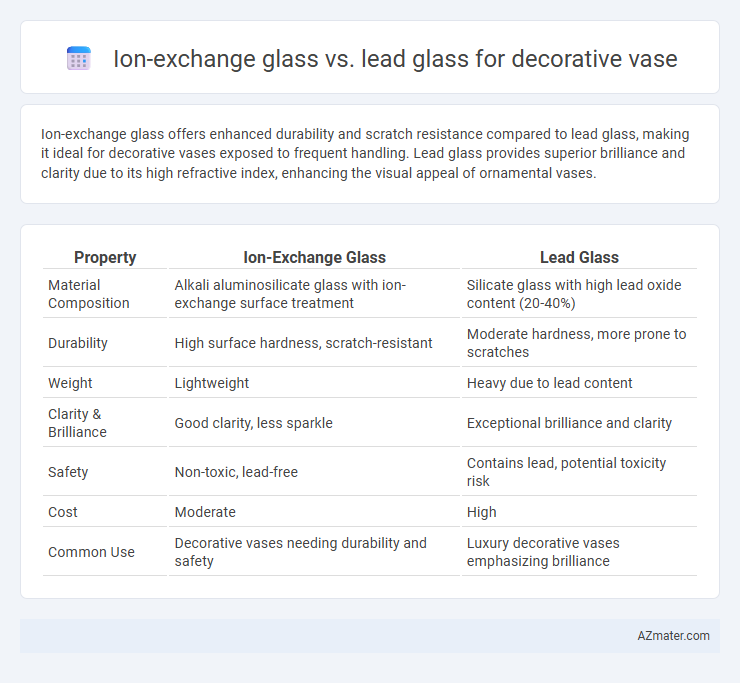Ion-exchange glass offers enhanced durability and scratch resistance compared to lead glass, making it ideal for decorative vases exposed to frequent handling. Lead glass provides superior brilliance and clarity due to its high refractive index, enhancing the visual appeal of ornamental vases.
Table of Comparison
| Property | Ion-Exchange Glass | Lead Glass |
|---|---|---|
| Material Composition | Alkali aluminosilicate glass with ion-exchange surface treatment | Silicate glass with high lead oxide content (20-40%) |
| Durability | High surface hardness, scratch-resistant | Moderate hardness, more prone to scratches |
| Weight | Lightweight | Heavy due to lead content |
| Clarity & Brilliance | Good clarity, less sparkle | Exceptional brilliance and clarity |
| Safety | Non-toxic, lead-free | Contains lead, potential toxicity risk |
| Cost | Moderate | High |
| Common Use | Decorative vases needing durability and safety | Luxury decorative vases emphasizing brilliance |
Introduction to Decorative Vase Materials
Ion-exchange glass offers enhanced durability and scratch resistance due to its surface compression layer, making it ideal for decorative vases that require long-lasting clarity and strength. Lead glass, known for its high refractive index and brilliance, provides exceptional weight and sparkle, enhancing the visual appeal of decorative vases with intricate light refraction. Both materials serve distinct aesthetic and functional purposes, with ion-exchange glass prioritizing toughness and lead glass emphasizing ornate elegance.
What is Ion-Exchange Glass?
Ion-exchange glass is a type of strengthened glass created through a chemical process that replaces smaller ions in the glass surface with larger ions, increasing hardness and resistance to scratches and impacts. Unlike lead glass, which contains lead oxide to enhance brilliance and weight, ion-exchange glass offers superior durability without added toxicity, making it ideal for decorative vases exposed to handling and environmental stress. The enhanced surface strength of ion-exchange glass ensures long-lasting clarity and aesthetic appeal while maintaining safety and environmental friendliness.
Properties and Characteristics of Ion-Exchange Glass
Ion-exchange glass offers superior surface hardness and scratch resistance compared to lead glass, making it ideal for maintaining the pristine appearance of decorative vases over time. This type of glass undergoes a chemical strengthening process that replaces smaller ions with larger ones on its surface, resulting in enhanced durability and impact resistance. Unlike lead glass, ion-exchange glass is also more environmentally friendly and safer, as it contains no toxic lead content while providing excellent clarity and brilliance.
What is Lead Glass?
Lead glass, also known as lead crystal, is a type of glass distinguished by its high lead oxide content, typically between 18% and 40%, which enhances its clarity, brilliance, and weight. This increased refractive index allows lead glass decorative vases to exhibit exceptional sparkle and a smooth, lustrous surface. Compared to ion-exchange glass, lead glass is softer and more prone to scratches but offers superior aesthetic qualities prized in ornamental applications.
Properties and Characteristics of Lead Glass
Lead glass, known for its high refractive index and exceptional clarity, enhances the brilliance and sparkle of decorative vases. Its density and softer texture allow intricate cuts and engravings, creating detailed and elegant designs unmatched by ion-exchange glass. The weight and luminosity of lead glass impart a luxurious feel, making it a preferred choice for artful and ornamental glassware.
Aesthetic Differences: Ion-Exchange vs Lead Glass
Ion-exchange glass offers a clearer, brighter surface with enhanced scratch resistance, contributing to a modern, sleek aesthetic ideal for contemporary decorative vases. Lead glass, with its high refractive index and weight, produces deep brilliance and luxury through its sparkling, prismatic effects, favored for traditional or classic vase designs. The choice between ion-exchange and lead glass significantly impacts vase appearance by balancing durability and luster against brilliance and ornate light dispersion.
Durability and Strength Comparison
Ion-exchange glass offers superior durability and strength compared to lead glass, thanks to its chemically strengthened surface that enhances resistance to scratches and breaks. Lead glass, while prized for its brilliance and clarity, is inherently softer and more prone to chipping or cracking under impact. For decorative vases, ion-exchange glass ensures longer-lasting structural integrity and better withstands everyday handling and environmental stress.
Safety and Environmental Considerations
Ion-exchange glass offers enhanced safety for decorative vases due to its higher chemical durability and resistance to cracking compared to lead glass, which contains toxic lead oxide posing health risks during production or disposal. Environmentally, ion-exchange glass is more sustainable since it avoids lead contamination, reducing soil and water pollution concerns associated with lead glass disposal. Choosing ion-exchange glass supports safer indoor air quality and aligns with eco-friendly practices by minimizing hazardous waste.
Cost and Availability for Decorative Vases
Ion-exchange glass offers a cost-effective alternative to lead glass due to its lower raw material and manufacturing expenses, making it more accessible for decorative vases. Lead glass, known for its brilliance and weight, tends to be more expensive and less readily available because of stricter regulations and higher production costs. Availability of ion-exchange glass is increasing as demand for safer, budget-friendly decorative options grows, while lead glass remains limited to specialized suppliers.
Choosing the Right Glass for Decorative Vases
Ion-exchange glass offers superior scratch resistance and durability compared to lead glass, making it ideal for decorative vases exposed to frequent handling or environmental stress. Lead glass, known for its high refractive index and brilliance, enhances light refraction and visual appeal, providing a luxurious aesthetic in decorative pieces. Selecting between ion-exchange and lead glass depends on prioritizing either long-term durability or enhanced optical clarity for the decorative vase's intended use and display environment.

Infographic: Ion-exchange glass vs Lead glass for Decorative vase
 azmater.com
azmater.com